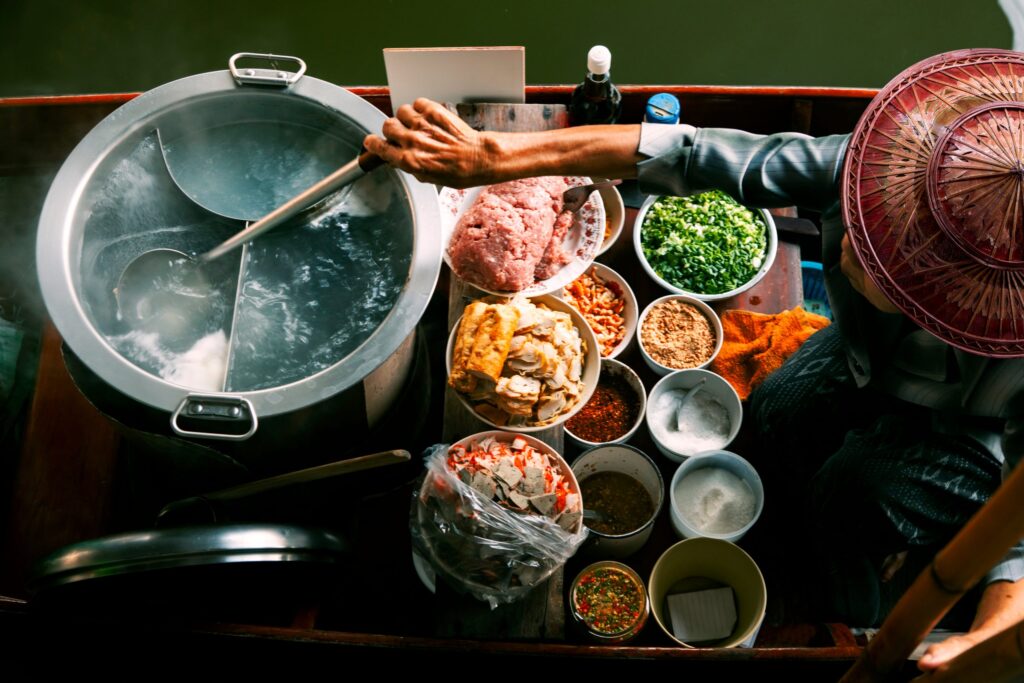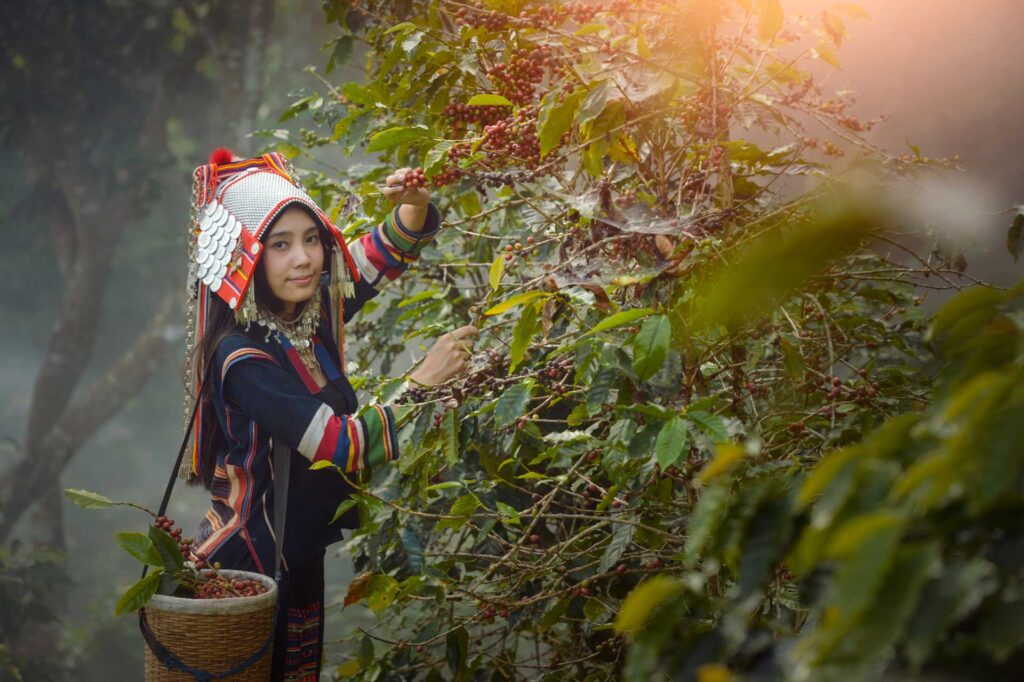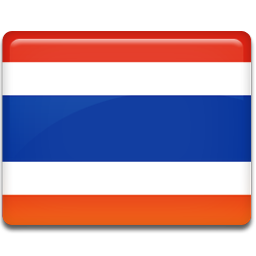The only country in Southeast Asia never colonized, Thailand was known for centuries as Siam until 1939 and again between 1945 and 1949. On May 11, 1949, an official proclamation changed the name of the country to ‘Thailand’ or ‘Prathet Thai’ (in Thai language), by which it has since been known. The word ‘Thai’ means ‘Free’, and therefore ‘Thailand’ means ‘Land of the Free.’
thailand_flagThailand’s distinctive and unparalleled characteristics stem from Indian and Chinese influences (harmoniously blended by Thai eclecticism), rich ethnic diversity, abundant natural and human resources, and over seven hundred years of cherished independence. Thailand’s traditional culture is delicately tuned to the time-honoured Buddhist’s non-confrontational approach to life, and ideals of charity, tolerance and loving-kindness.
Over the early centuries of the Common Era, tribes of Mon, Khmer, and Tai peoples established realms within the borders of modern Thailand; the Mon speaking Buddhist civilization of Dvaravati in the first millennium giving way to the Khmer empire of Angkor by the turn of the second millennium. However, the history of Thailand as we know it began when the kingdoms of Lan Na (Chiang Rai/Chiang Mai) and Sukhothai, the first truly independent Thai Kingdoms, established highly developed societies in the North and Central regions of Thailand in the 13th and 14th centuries. The Kingdom of Ayutthaya, which was heavily influenced by the Khmer’s of Angkor, eventually conquered neighboring Sukhothai and dominated the region for the next several hundred years of Thai history.
Unfortunately, first Chaing Mai and then Ayutthaya were overrun by Burmese invaders, who occupied the Lan Na capital for several centuries and sacked Ayutthaya, forcing the central Thai kingdom to relocate farther south, establishing a new capital in Thon Buri near Bangkok. After the short lived Thon Buri Period (1767-1772), the capital was moved across the Chao Phraya River, and the first of the current line of Kings, Rama I of the Chakri Dynasty, established the modern capital of Bangkok to commence the Ratanakosin Period of Thai history. The adroit diplomatic leadership of Kings Mongkut (Rama IV, 1851-1868) and Chulalongkorn (Rama V, 1868-1910) were responsible for maintaining a remarkable 700 year Thai history during which the kingdom was never officially colonized by foreign powers; a turbulent 20th century witnessed the transition to a system of constitutional monarchy, currently overseen by Head of State, King Bumibol Adulyadej (1946- present), is King Rama IX of the Chakri Dynasty and a tenuous but functional democracy has existed under the regency of this much beloved king.
Located in the center of Southeast Asia, Thailand is truly at the heart of the region. Looking over a map of Thailand will reveal a country whose borders form the rough shape of an elephant’s head: the head and ears forming the mostly landlocked northern and eastern provinces and the trunk extending down the Malaysian peninsula between the Andaman Sea and the Gulf of Thailand.
The geography of Thailand features many natural borders with neighboring countries: a mountainous border with Myanmar (Burma) to the north and west; a long stretch of the Mekong River separating Thailand from Laos to the north and east; and the Mekong River and the Dongrak Mountains delineating the border of Cambodia to the east.
Covering an area of approximately 514,000 square kilometers (200,000 sq miles), Thailand is the 50th largest country in the world, most nearly equal in size to Spain. Located just 15 degrees north of the equator, Thailand has a tropical climate and temperatures typically range from 19 to 38 degrees C (66-100 F); monsoon rains fall predominately from May to July and cooler, drier weather occurs around November and December.
Thailand can best be described as tropical and humid for the majority of the country during most of the year. The area of Thailand north of Bangkok has a climate determined by three seasons whilst the southern peninsular region of Thailand has only two. Generally speaking, the best time to visit Thailand is from November to February when the northeast monsoon is blowing cool, dry air which serves as a respite from the heat. During this cool season, the temperature ranges from 18ºC to 32ºC in Bangkok, while in northern and northeast Thailand, temperatures can get quite cool with morning temperatures as low as 8º C to 12º C with the occasional 20º C day. Nights can be particularly chilly and at high altitudes the temperatures can and do drop below freezing.
The summer period, or hot and dry season, is from March to June. At this time temperatures in Bangkok average around 34º C, but can often reach 40º C with the humidity levels of 75%.
Try and avoid April, unless you plan to be permanently submerged in the ocean, because this is the hottest month across the country.
The monsoons finish when the wind direction changes, bringing dry weather from the northeast. At best this season can be described as unpredictable and not the constant downpour of rain like you would expect. The middle months of this season may hold particularly heavy rains for the north of the country.
While roughly 95% of the Thai people are practitioners of Theravada Buddhism, the official religion of Thailand, religious tolerance is both customary in Thailand and protected by the constitution. By its very nature however, Buddhism, which is based on the teachings of the Buddha, “the enlightened one” (nee Siddhartha Gautama), is a compassionate and tolerant religion, the aim of which is the alleviation of suffering. Consequently, Thai people are very respectful of the religious beliefs of others and are very open toward discussing their Buddhist values with visitors. In fact, there are many opportunities in Thailand to visit Buddhist temples to learn about or study Buddhism and perhaps to learn to meditate.
Religion in Thailand pervades many aspects of Thai life and senior monks are highly revered; it is not uncommon to see their images adorning walls of businesses or homes or upon ornaments inside of taxi cabs. In many towns and villages the neighborhood wat (temple) is the heart of social and religious life. Buddhist holidays occur regularly throughout the year (particularly on days with full moons) and many Thai people go to the wat on these and other important days to pay homage to the Buddha and give alms to monks in order to make merit for themselves.
Meditation, one of the primary practices of Buddhism, is a means of self reflection in order to identify the causes of individual desire and ultimately alleviate ones suffering. Visitors can learn the fundamentals of this practice at a number of wats across the kingdom. Some temples, particularly in Chiang Mai, allow visitors to chat with monks in order to gain general knowledge about Buddhism or to study Buddhism more seriously.
While Theravada Buddhism may technically be considered a philosophy rather than a religion (there is no ‘God’) Thai Buddhism is infused with many spiritual beliefs which are likely the result of lingering animist and Hindu beliefs from centuries earlier. Most Thai homes and places of business feature a ‘spirit house’ just outside the building, where offerings are made to appease spirits that might otherwise inhabit their homes or workplaces. Furthermore, Buddhist monks are often brought to new homes and businesses to ‘bless them’, and Thai people frequently light incense and make prayers to both Buddha images and a host of Hindu gods whose shrines are located throughout Bangkok and the countryside.
The next largest religion in Thailand, Islam, is practiced by only about 4% of the population; the majority of Thai Muslims live in the most southerly provinces near the Malaysian border. Other religions in Thailand include Hinduism, Confucianism, Taoism, and Christianity, which are generally practiced by those living in Bangkok, where a multi-cultural population includes citizens of Indian, Chinese, Japanese, and European descent.
Thai culture is incredibly warm and welcoming; Thai people are both open to other people’s religious and political beliefs and very proud of their own culture. However, while sensitive to the behaviour of others, Thai people follow some cultural practices that can be awkward for some visitors. Typically, Thais will not show overt displeasure at someone violating these Thailand cultural norms. Such behaviour is actually an important aspect of Thai culture: Thais do not get visibly upset at others! That said, it’s better to be aware of these aspects of Thai culture and behave accordingly. In Thai culture, people have a deep, traditional reverence for the royal family, and visitors should be careful to show respect for the King, the Queen and the royal family, as well as any image of royal family members. It is unacceptable to speak ill of the royal family and it is required by both the standards of Thai culture as well as Thai law to stand in honour of the King prior to movie screenings and other public events.






